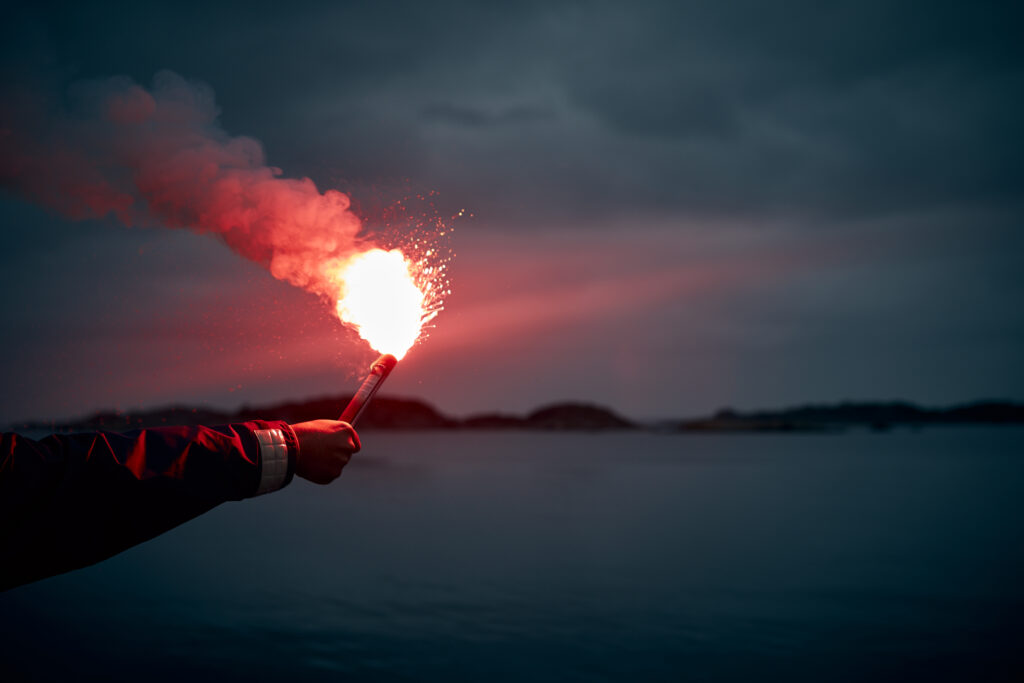Ensuring safety at sea is paramount for all mariners. One of the most effective means of signalling distress is using pyrotechnic flares. IKAROS flares are renowned for their reliability and compliance with international safety standards. This guide delves into the types of flares available, their proper usage, relevant UK and EU regulations and the integration of modern electronic alternatives.
Types of flares
There are a range of IKAROS flares designed to cater to various maritime distress signalling needs:
Red parachute rocket – These flares are designed for long-range distress signalling. When activated, they project a bright red flare to an altitude of approximately 300 metres, burning for about 40 seconds while descending slowly. This makes them visible over vast distances. They are suitable for both day and night use. However, caution is advised when using them near aircraft, as they can pose a hazard to low-flying helicopters.
Red handheld flares – Ideal for short-range signalling, these flares emit a bright red light visible for several miles and burn for approximately 60 seconds. They are most effective when immediate assistance is nearby, such as another vessel or a rescue helicopter. It’s essential to hold the flare downwind, away from the body, and over the side of the vessel to prevent injury or fire hazards.
Orange hand held smoke – Designed exclusively for daytime use, it produces dense orange smoke for about 60 seconds, making them highly visible to aircraft and vessels during daylight hours. They are particularly useful for pinpointing a vessel’s location once a distress alert has been made.
Proper usage of flares
Understanding the correct deployment of flares is crucial:
- Storage: Keep flares in a cool, dry and easily accessible location. Ensure they are stored in a watertight container to prevent moisture damage.
- Activation: Always read the manufacturer’s instructions before use. When igniting, hold the flare at arm’s length, pointed away from the body, and over the side of the vessel.
- Safety precautions: Wear protective gloves and eye protection if available. Be aware of the wind direction to prevent burns or accidental ignition of flammable materials on board.
- Disposal: Expired flares are hazardous and must be disposed of properly. In the UK, contact local maritime authorities or the supplier for guidance on safe disposal methods.
Integration of electronic flares
While Electronic Visual Distress Signals (EVDS) are emerging as alternatives, they are not yet universally recognised under the International Regulations for Preventing Collisions at Sea (COLREGs) as primary distress signals. Therefore, traditional pyrotechnic flares remain a requirement for many vessels.
However, they still offer certain advantages:
- Longevity: Electronic flares can operate for extended periods, providing continuous signalling without the short burn time limitation of pyrotechnic flares.
- Safety: They eliminate the fire hazards associated with pyrotechnics, making them safer to handle and store.
Electronic flares may not be as visible over long distances compared to traditional smoke signals, especially during daylight. For optimal safety, it’s advisable to carry both pyrotechnic and electronic signalling devices, ensuring versatility in various emergency scenarios.
Ocean Safety’s flare packs
To meet diverse maritime safety needs, Ocean Safety offers a range of flare packs, including:
- Inshore pack: Designed for use up to 5 miles from land, this pack includes two red handheld flares and two orange handheld smokes, suitable for short-range distress signalling.
- Offshore pack: Ideal for distances up to 10 miles from land, it contains four red parachute rocket flares, four red handheld flares and two orange buoyant smoke signals, providing comprehensive signalling options for various situations.
- RORC pack: Compliant with the Royal Ocean Racing Club and World Sailing Special Regulations, this pack includes four red handheld flares and two orange buoyant smoke signals, all packaged in a water-resistant and compact container for easy storage and access.
Each pack is curated to ensure mariners are equipped with the necessary tools to signal for help effectively, adhering to safety regulations and best practices.
Safety at sea relies heavily on effective distress signalling. IKAROS flares, known for their quality and compliance, offer reliable solutions for mariners. By understanding the types of flares available, their proper usage and current regulations, seafarers can enhance their preparedness for emergencies.
For more information on Ocean Safety’s range of flare packs and safety equipment, visit www.oceansafety.com

